Imagine yourself as a chemist, carefully orchestrating a dance between resin and hardener. Like a skilled conductor, you measure, mix, and watch as the two components intertwine, forming a bond that will transform from liquid to solid.
But there's more to this process than meets the eye. How does temperature affect the cure time? What role does surface preparation play? And how can you ensure a dependable bond?
As you embark on this journey into the world of epoxy resin curing, prepare to uncover the answers to these questions and more.
Key Takeaways
- Accurate measurement and thorough mixing of epoxy resin and hardener are essential for proper curing.
- The resin-to-hardener ratio determines the curing process, and it is important to follow the recommended mix ratio.
- Temperature plays a significant role in the epoxy curing process, with warmer temperatures accelerating the cure time.
- Proper mixing techniques, including uniform distribution and scraping the sides, aid in achieving a well-mixed application.
Basics of Epoxy Dispensing
To ensure proper curing of epoxy, it's crucial to carefully measure and thoroughly mix the resin and hardener. The curing process of epoxy is highly dependent on the correct ratio of resin to hardener. Begin by creating a small test batch to determine the epoxy's open time and the resin-to-hardener ratio needed for your project. Accurate dispensing of the resin and hardener is essential, and using Entropy Pumps can help achieve precise ratios. Follow the pump instructions for calibration and troubleshooting to ensure accurate dispensing.
During the curing process, epoxy goes through different states – liquid, gel, and solid. The time it takes for epoxy to cure varies depending on the temperature. Warmer temperatures accelerate the curing process, while cooler temperatures lengthen the cure time. It's important to consider the ambient temperature and adjust the curing time accordingly.
Proper surface preparation is also crucial for epoxy curing. Ensure that the surface is clean, dry, and free from any contaminants that may interfere with the epoxy's adhesion. This will help achieve a strong bond between the epoxy and the substrate.
Measuring & Mixing Epoxy Resin and Hardener
To ensure proper curing of epoxy resin, it's crucial to measure and mix the resin and hardener in the correct ratios. Carefully follow the instructions provided on the hardener label or technical data sheet to determine the proper mix ratio.
Additionally, it's important to use proper mixing techniques and consider factors such as time and temperature to achieve optimal results.
Proper Ratios for Mixing
For precise and accurate epoxy resin curing, it's essential to ensure the proper ratios are used when measuring and mixing the epoxy resin and hardener. The correct mix ratio can be found on the hardener label or technical data sheet.
Whether you measure by weight or volume, it's crucial to be consistent to achieve the desired chemical reaction. To avoid wastage, start by mixing small batches until you're confident with the handling characteristics.
Always verify the ratio before using the mixture on your project to avoid any unwanted surprises. Using a scale to measure the desired weight accurately will help you achieve the correct ratio.
Mixing Techniques
Careful and precise measuring, as well as thorough mixing, are vital steps in ensuring the proper curing of epoxy resin. The correct mix ratio of resin and hardener should be followed for optimal results. Whether measured by weight or volume, it is important to follow the recommended mixing instructions provided by the manufacturer. To emphasize the importance of mixing techniques, consider the following table:
| Mixing Technique | Benefits |
|---|---|
| Stirring | Ensures uniform distribution of resin and hardener |
| Scrape the Sides | Prevents unmixed portions from remaining |
| Mixing Speed | Affects the amount of heat generated during curing |
| Mixing Time | Influences the epoxy cure time |
Proper mixing techniques aid in achieving a well-mixed application. The working speed also impacts the amount of heat produced during the chemical reaction. Remember, the more efficient the mixing, the better the epoxy cure.
Time and Temperature Factors
Temperature and time are critical factors to consider when measuring and mixing epoxy resin and hardener for optimal curing. The epoxy resin curing process is influenced by these factors, as they affect the chemical reaction and cure time. Here are three important considerations:
- Temperature: The ambient temperature has a significant impact on the cure time of epoxy resin. Warmer temperatures accelerate the curing process, while cooler temperatures prolong it. It's crucial to work within the recommended temperature range for the specific epoxy resin and hardener being used.
- Cure Time: The cure time is the duration required for the epoxy resin to fully harden. It varies depending on the temperature and the specific epoxy formulation. Understanding the expected cure time helps in planning and ensuring the resin achieves its desired properties.
- Exothermic Heat: During the curing process, epoxy resin generates exothermic heat. Higher temperatures can intensify this heat production, affecting the working time available before the resin becomes unworkable. Monitoring and managing the temperature is essential to maintain a suitable working time.
Dispensing Resin and Hardener
To properly dispense epoxy resin and hardener, ensure that you have measured the correct ratio of the two components. This step is crucial in achieving a successful epoxy resin curing process. The ratio of resin to hardener determines the chemical reaction that takes place during the curing process. It's important to follow the manufacturer's instructions and use precise measurements to ensure the desired outcome.
When dispensing the epoxy resin and hardener, consider the working speed and the surface on which the epoxy will be applied. The working speed refers to the amount of time you have to mix and apply the epoxy before it begins to cure. The surface should be clean, dry, and free from any contaminants to ensure proper adhesion.
The amount of epoxy resin and hardener to be dispensed depends on the size of the project and the desired thickness of the epoxy coating. It's recommended to mix small amounts of epoxy at a time to avoid wastage and to maintain control over the curing process.
Once the resin and hardener are dispensed, thoroughly mix them together until a homogeneous mixture is achieved. This step ensures that the chemical reaction between the two components is initiated, leading to the curing process. It's important to mix the epoxy thoroughly to avoid any uncured or weak spots in the final cured mass.
During the curing process, an exothermic heat is generated as a result of the chemical reaction between the epoxy resin and hardener. This heat helps to accelerate the curing process and ensures a strong and durable final product. It's essential to monitor the temperature during curing to prevent overheating, which can affect the final outcome.
Mixing Resin and Hardener
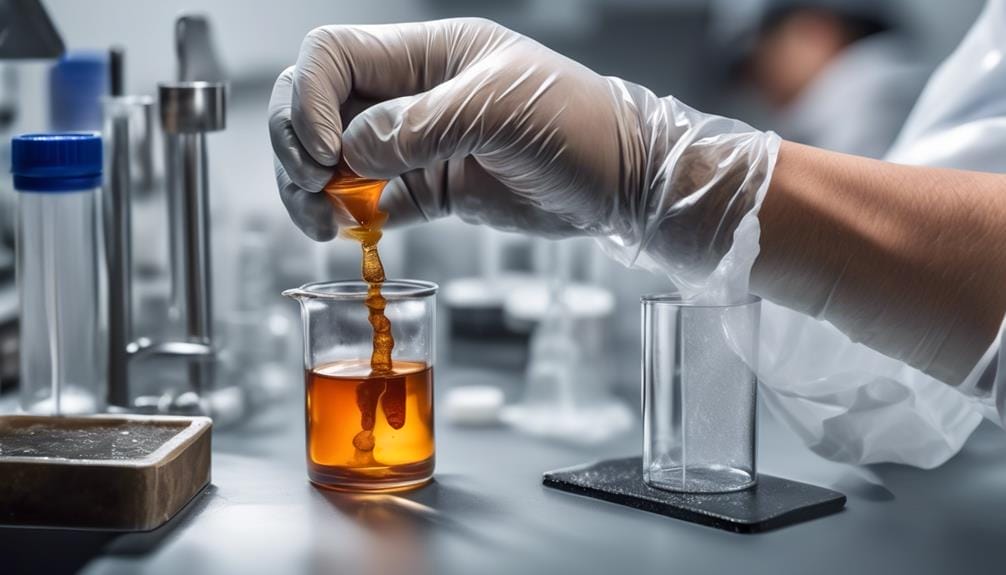
Mix the epoxy resin and hardener together in the correct ratio to ensure proper curing. Careful measuring and thorough mixing are essential for the epoxy resin curing process. Check the hardener label or technical data sheet for the correct mix ratio. Begin with a small test batch to understand the epoxy's open time and resin-to-hardener ratio. It's crucial to mix small batches until you're confident of the handling characteristics. Before using the mixture on a project, always verify the ratio.
When mixing epoxy resin and hardener, remember that a chemical reaction occurs between the two components. Achieving the correct mix ratio is vital for a successful curing process. Incorrect ratios can result in incomplete curing or compromised strength.
The ambient temperature also plays a significant role in the curing of epoxy. Higher temperatures generally accelerate the curing process, while lower temperatures can slow it down. Consider the ambient temperature when determining the appropriate curing time for your epoxy mixtures.
Understanding the initial cure phase is essential in epoxy chemistry. This phase refers to the time it takes for the epoxy to harden to a point where it can be handled or further manipulated. Following the recommended curing time ensures that the epoxy reaches its full strength and durability.
Properly mixing epoxy resin and hardener, considering the ambient temperature, and adhering to the recommended curing time are crucial steps in achieving a successful epoxy resin curing process.
Epoxy Cure Stages
Now that you understand the importance of properly mixing epoxy resin and hardener, it's crucial to delve into the epoxy cure stages to ensure a successful curing process.
Curing epoxy involves a chemical reaction between the resin and hardener, which transforms the liquid mixture into a solid material with desirable properties. The curing process consists of three main stages: liquid, gel, and solid.
During the liquid stage, the mixed epoxy is in a fluid state and can be easily manipulated for assembly and clamping. As time progresses, the epoxy starts to thicken and enters the gel stage. At this point, the epoxy is no longer workable and begins to transition into a firm rubber-like consistency. The gel stage indicates that the chemical reaction is underway.
Finally, the epoxy reaches the solid stage, where it has cured to its ultimate strength. The epoxy is now in its solid state and can be subjected to normal use and stress. The time it takes for epoxy to go through these stages depends on various factors, including temperature.
Higher temperatures accelerate the epoxy curing process, while cooler temperatures prolong it. It's important to note that the curing process also generates exothermic heat, which can further impact the epoxy's temperature. To control the curing process, slower hardeners can be used in warmer conditions, while faster hardeners are suitable for cooler temperatures.
Understanding the epoxy cure stages allows for better control over the curing process. By monitoring the epoxy's gel consistency and considering the temperature and hardener choice, you can achieve optimal results and ensure the epoxy cures to its desired solid state.
Liquid – Open Time
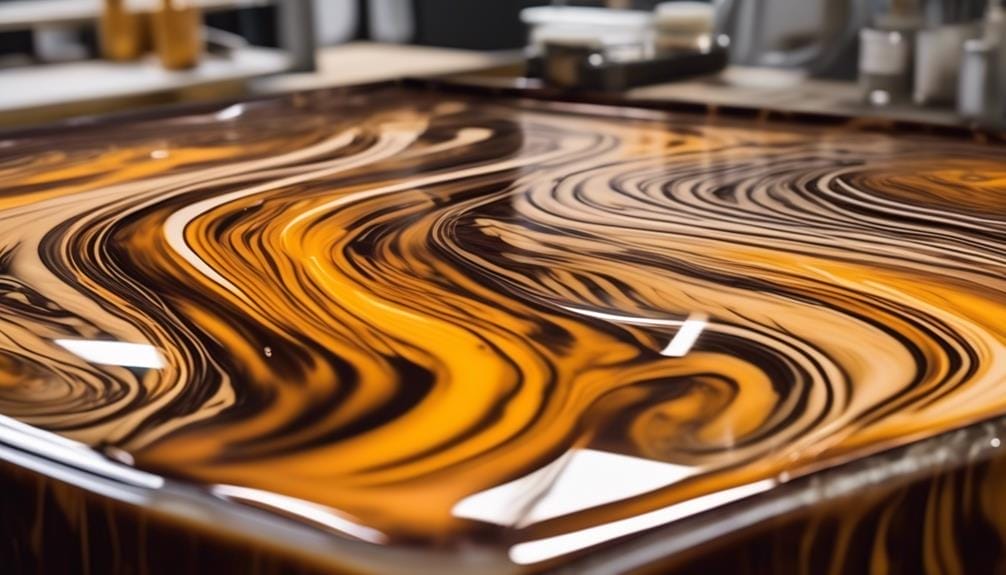
During the liquid phase, also known as the open time, it's crucial to consider the factors that can affect the curing time, such as temperature and humidity.
These variables can impact the length of the open time and ultimately the strength of the bond.
Curing Time Factors
The open time, or working time, of epoxy resin is a crucial factor in the curing process, as it determines the period in which the resin remains in a liquid state and can be applied for assembly and clamping.
The curing time of epoxy resin is influenced by several factors, including temperature and the type of hardener used. Here are three key factors that affect the curing time:
- Temperature: Higher temperatures accelerate the chemical reaction between the resin and hardener, resulting in a shorter curing time. Conversely, lower temperatures slow down the reaction, prolonging the curing process.
- Heat generated: The curing process of epoxy resin is exothermic, meaning it generates heat as the chemical reaction progresses. This exothermic heat can impact the curing time, especially in large or thick applications, where the heat generated may affect the resin's overall performance.
- Type of hardener: Different hardeners have varying curing characteristics, affecting the overall curing time. It's essential to choose the appropriate hardener for the specific application to ensure optimal curing and performance.
Understanding these curing time factors is crucial for achieving successful epoxy resin applications, as it allows for proper planning and execution of assembly and clamping processes.
Temperature and Humidity
To further explore the impact of temperature and humidity on the epoxy resin curing process, let's now shift our focus to the subtopic of 'Temperature and Humidity' (Liquid – Open Time).
The temperature and humidity during the liquid-open time stage play a crucial role in the curing of epoxy. Warmer temperatures generally result in faster curing, while cooler temperatures slow down the process. Both ambient temperature and surface temperature can affect the cure time.
It's important to note that the exothermic heat generated during the epoxy's chemical reaction also contributes to the epoxy temperature. In warmer conditions, slower hardeners can be used to maintain a longer open time. Conversely, in cooler conditions, supplemental heat or faster hardeners may be utilized to expedite the curing process.
Gel – Initial Cure Phase
In the initial cure phase of the epoxy resin curing process, the gel phase signifies that the epoxy has transitioned from a workable state to a firm rubber-like consistency. This phase is characterized by the epoxy becoming tack-free and changing from a tacky, gel-like substance to a more solid and rubbery state. During this phase, a chemical reaction occurs between the hardener and the resin, which causes the epoxy to harden and cure.
Here are three key points to consider during the gel phase of the initial cure phase:
- Cure time: The gel phase is an important stage in the curing process, as it determines the overall cure time of the epoxy resin. The length of this phase can vary depending on factors such as ambient temperature and the specific hardener and resin used.
- Heat produced: As the epoxy resin cures, it generates heat. This heat is a byproduct of the chemical reaction taking place during the gel phase. It's important to monitor the temperature during curing to ensure that it doesn't exceed the recommended range and compromise the final quality of the epoxy.
- Clamping: During the gel phase, the epoxy reaches most of its ultimate strength. This means that clamps can be removed at this stage, as the epoxy has achieved sufficient bonding and adhesion. However, it's still essential to allow the epoxy to fully cure before subjecting it to any stress or load.
Understanding the gel phase of the initial cure phase is crucial for achieving optimal results when working with epoxy resin. By closely monitoring the cure time, heat generated, and appropriate clamping techniques, you can ensure a successful and durable epoxy resin cure.
Solid – Final Cure Phase
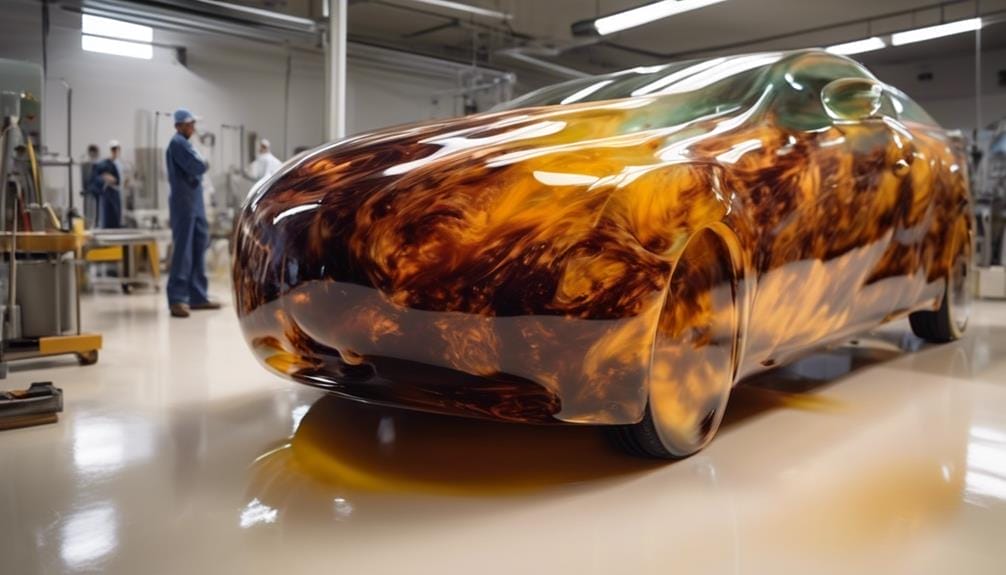
During the solid – final cure phase, the epoxy resin has fully cured to a solid state and can no longer be dented with a thumbnail. At this point, the epoxy has reached most of its ultimate strength, and clamps can be removed.
However, it's important to note that a new application of epoxy requires surface preparation to achieve a mechanical bond, as the epoxy continues to cure for several days to two weeks at room temperature.
Proper surface preparation is essential for recoating after the final cure. It's during this phase that the epoxy achieves maximum heat and chemical resistance, which typically takes around four days. The final curing process can be influenced by various factors, including temperature, mixing ratio, impurities, and contamination. Therefore, it's crucial to adhere to optimal conditions and follow the recommended mixing processes.
During the solid – final cure phase, a chemical reaction occurs within the epoxy mixture, resulting in heat generation. This heat aids in the curing process and allows the epoxy to solidify. It's important to consider the ambient temperature during this phase, as higher temperatures can accelerate the cure time, while lower temperatures can slow it down.
Epoxy Temperature and Curing
As we move into the topic of 'Epoxy Temperature and Curing', it's important to understand how temperature influences the curing process, building upon our previous discussion on the solid – final cure phase.
The temperature at which epoxy cures plays a crucial role in the overall process. Here are some key points to consider:
- Warmer temperatures result in faster epoxy curing. Higher temperatures accelerate the chemical transformation from liquid to solid, allowing the epoxy to cure more quickly. This can be advantageous when working on time-sensitive projects or when multiple layers need to be applied within a short timeframe.
- Ambient temperature and surface temperature affect the cure time. The temperature of the surrounding environment and the temperature of the surface being coated can impact the curing process. It's important to ensure that both temperatures are within the recommended range for optimal curing.
- The heat produced during the curing process depends on the epoxy mixture's open time and the exothermic reaction. Epoxy mixtures have a limited open time, during which they can be applied and will still cure properly. The exothermic reaction that occurs during curing can quickly generate enough heat to further accelerate the curing process.
To control the temperature of curing epoxy, supplemental heat can be used in cooler conditions. This helps to ensure that the epoxy reaches and maintains the desired temperature for curing.
How Volume Affects Exothermic Reactions
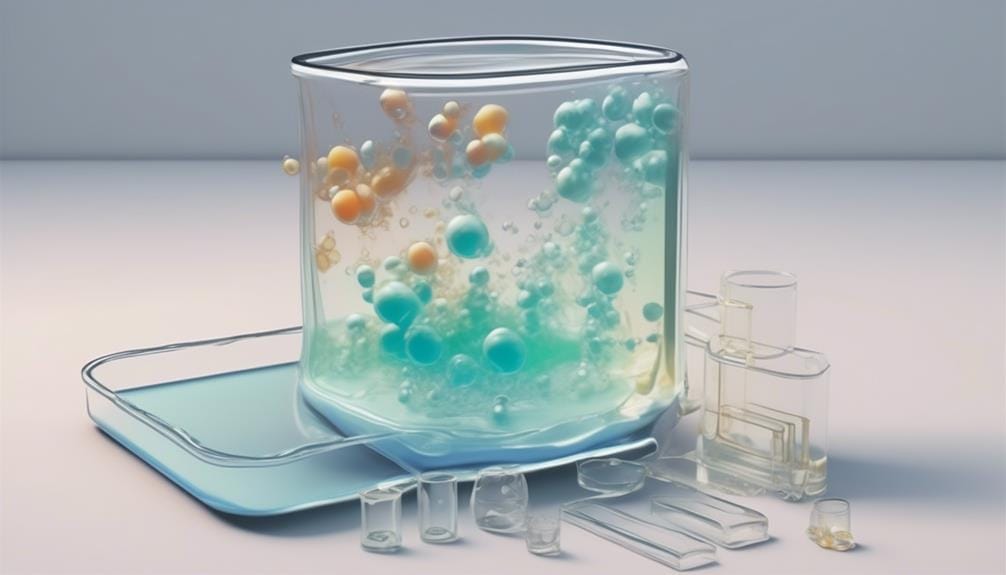
Thicker epoxy masses exhibit a greater heat generation and faster reaction rate in exothermic reactions. The cure speed of epoxy resins is influenced by the volume and mass of the epoxy. When larger amounts of epoxy are present, a more significant amount of heat is generated during the curing process. This heat accelerates the chemical reaction that cures the epoxy. On the other hand, thinner layers of epoxy cure slower due to the reduced heat impact.
The amount of heat generated during the exothermic reaction in epoxy curing depends on the epoxy mass or exposed surface area. A larger volume of epoxy results in a higher heat generation because there's more material available for the chemical reaction. This increased heat, in turn, speeds up the cure time of the epoxy. Conversely, a smaller volume of epoxy produces less heat, leading to a slower cure time.
It is important to note that the ambient temperature also plays a role in the curing process. Warmer temperatures result in faster curing, as the heat generated during the exothermic reaction is further accelerated. However, extreme temperatures can also cause issues, such as excessive heat buildup, which may affect the integrity of the epoxy.
Hardener Cure Speed
When considering the hardener cure speed, it's important to understand the factors that influence the cure time. These factors include the temperature at which the epoxy is applied and the specific hardener chosen.
Warmer temperatures will result in a faster curing process, while cooler temperatures will extend the cure time.
Cure Time Factors
The cure time of epoxy resin is determined by the speed at which the hardener cures and is influenced by the temperature of the epoxy. Two factors determine the cure time: the hardener cure speed and the epoxy temperature.
Here are three important factors to consider:
- Temperature: Heat speeds up the epoxy curing process, while cooler temperatures slow it down. It's crucial to maintain the recommended temperature range for the epoxy to cure properly.
- Hardener selection: Choosing the right hardener is essential for providing adequate working time based on the prevailing temperature and conditions. Using a hardener that suits the specific application and temperature can optimize the curing process.
- Surface preparation: The epoxy must be properly prepared and sanded before application. This ensures proper adhesion and allows the chemical reaction that transforms the epoxy from liquid to solid to occur effectively.
Accelerating Cure Process
To accelerate the cure process of epoxy resin, it's essential to carefully consider the hardener cure speed and its compatibility with the specific temperature and conditions. The hardener cure speed determines the amount of time available for mixing, application, and clamping.
When the hardener is mixed with the epoxy resin, a chemical reaction begins. The mixed epoxy passes through a stage where the molecules are still chemically linked but can move around, causing a faster reaction. This generates enough heat to melt and cure the epoxy.
Preparing Surfaces for Adhesion
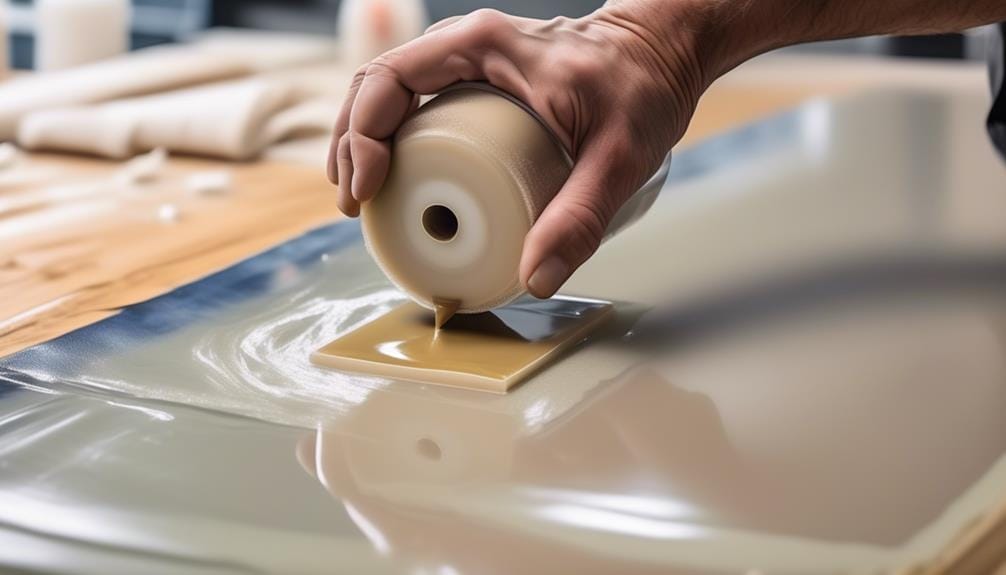
Properly preparing surfaces is crucial to ensure strong adhesion when working with epoxy resin. The adhesion of epoxy relies on the surface being clean, dry, and free from contaminants such as grease or mold release. To achieve this, it's important to clean the surfaces using appropriate solvents like lacquer thinner or isopropyl alcohol. Additionally, sanding the surfaces with 80-grit aluminum oxide paper creates the ideal texture for epoxy adhesion.
When preparing surfaces for adhesion with epoxy, it's important to consider the materials used for mixing. Plastic mixing cups aren't recommended as they can quickly react with the epoxy, affecting the curing process. Instead, it's advised to use glass mixing containers.
The shape of the mixing containers also plays a role in the curing process. Casting resins, for example, generate exothermic heat during the chemical reaction of epoxy. Using a wider and shallower mixing container can help dissipate this heat more effectively.
Furthermore, the cure time of epoxy is determined by the temperature at which it's cured. At room temperature, epoxy can take several days to reach its final cure. It's important to wait for the appropriate cure time before subjecting the epoxy to any stress or load.
Frequently Asked Questions
How Long Does 2 Part Epoxy Resin Take to Cure?
Epoxy resin curing time varies based on factors like curing temperature and mixing ratio. Humidity can affect the curing process, while factors like accelerating the process and post-curing techniques can be used. Proper curing is crucial for resin durability.
What Are the Stages of Epoxy Resin Curing?
The stages of epoxy resin curing include liquid, gel, and solid states. Factors like temperature and hardener speed affect curing time. Proper mixing is essential for strong adhesion. Different methods can accelerate curing. Hardness and strength can be evaluated. Techniques for achieving a smooth finish are important. Troubleshooting common issues is necessary.
How Do You Know if Epoxy Is Fully Cured?
To determine if epoxy is fully cured, visually inspect for a glossy, smooth surface. Conduct tactile testing by pressing firmly to ensure no impression is left. Assess chemical reactions, watch time lapse videos, test heat resistance, flexibility, water resistance, odor, and impact resistance.
Can You Dry Resin With a Hair Dryer?
You'll be pleased to know that you can dry resin with a hair dryer. Using low heat and keeping a safe distance will prevent damage and air bubbles.
Conclusion
In conclusion, mastering the epoxy resin curing process is like conducting a delicate symphony. Each step, from measuring and mixing to understanding cure stages and temperature effects, must be performed with precision and care.
Just as a skilled conductor brings together individual instruments to create a harmonious masterpiece, following recommended instructions and considering factors like surface preparation and hardener cure speed will ensure a dependable bond.
The end result? A solid-state epoxy that forms a strong foundation for your projects.





